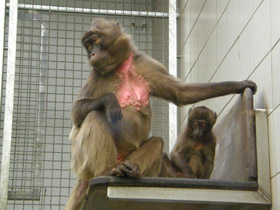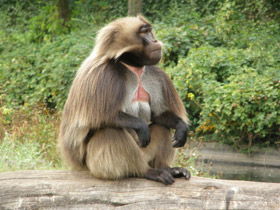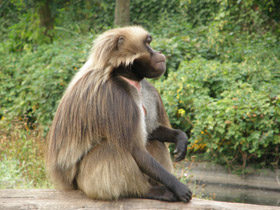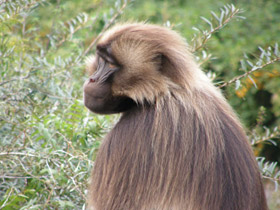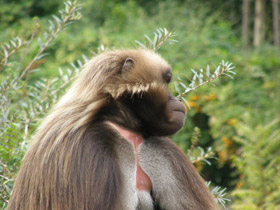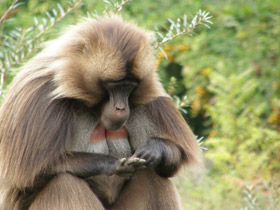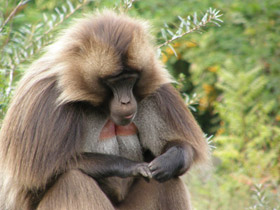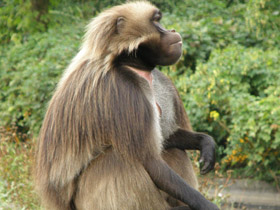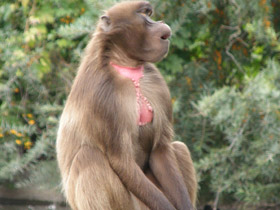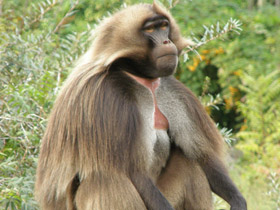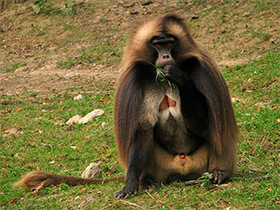The gelada (Theropithecus gelada), the bleeding-heart monkey or the gelada baboon
The gelada (Theropithecus gelada, Amharic: ጭላዳ, romanized: č̣əlada), sometimes called the bleeding-heart monkey or the gelada baboon, is a species of Old World monkey found only in the Ethiopian Highlands.
Taxonomy and evolution
Since 1979, the gelada is customarily placed in its own genus (Theropithecus), though some genetic research suggests that this monkey should be grouped with its baboon (genus Papio) kin; other researchers have classified the species even more distantly from Papio. While Theropithecus gelada is the only living species of its genus, separate, larger species are known from the fossil record: Theropithecus brumpti, Theropithecus darti and Theropithecus oswaldi, formerly classified under genus Simopithecus. Theropithecus, while restricted at present to Ethiopia, is also known from fossil specimens found in Africa and the Mediterranean into Asia, including South Africa, Malawi, the Democratic Republic of the Congo, Tanzania, Uganda, Kenya, Algeria, Morocco, Spain, and India (more exactly at Mirzapur, Cueva Victoria, Pirro Nord, Ternifine, Hadar, Turkana, Makapansgat, and Swartkrans).
The two subspecies of gelada are:
- Northern gelada, Theropithecus gelada gelada;
- Eastern gelada, southern gelada, or Heuglin's gelada, Theropithecus gelada obscurus.
Common Name
The gelada has been referred to by other names, including the "gelada baboon", "bleeding-heart baboon", or simply "baboon", implying a monophyletic relationship with baboons, which historically included (apart from Theropithecus) the genera Papio (true baboons), and Mandrillus (mandrills and drills). Since the 1990s, however, molecular phylogenetic studies clarified relationships among papionin monkeys, demonstrating that mangabeys of the genus Lophocebus are more closely related to Papio and Theropithecus, while mangabeys of the genus Cercocebus are more closely related to Mandrillus. These findings largely invalidated any scientifically based justification for referring to mandrills and drills as baboons, as doing so while excluding the unbaboon-like Lophocebus mangabeys would create a polyphyletic group. The status of geladas was less clear and the relationships among Papio, Lophocebus, and Theropithecus continue to reflect high levels of uncertainty, which are further complicated by the discovery of the kipunji. Nevertheless, the most recent and extensive phylogenetic study to date demonstrates that, while large fractions of the genome show an alternative history, the dominant relationship across the genome supports a closer relationship between Papio and Lophocebus, with Theropithecus as the outgroup. As a close sister relationship between Papio and Theropithecus is the least-supported scenario in recent studies, i "gelada baboon" and other names implying a close relationship with baboons, with increasing clarity, are not scientifically justified, leading researchers to advocate for the common name to be simply "gelada".
Appearance and peculiarities
Theropithecus gelada is a species of catarrhine primate of the family Cercopithecidae. Theropithecus gelada are large apes, weighing up to 25 kg or more; they have a non-furred tail about 50 cm long with a tassel of hair at the end; body length is 70-75 cm. The muzzle of Theropithecus gelada is rounded, with deep depressions in the cheek area and ridges on the cheeks. The hair of these monkeys is long, silky and brown in colour; males have a coat of long, chocolate-coloured hair covering the front of the body. Females are much smaller than males and have no coat.
An interesting peculiarity of Theropithecus gelada is the pale, bare areas of skin on the neck and chest. In females, these bare areas are surrounded by fleshy, neck-shaped outgrowths. When aroused and during sexual cycles, the excrescences overflow with blood and turn purple. In addition, there are two nipples so close together on the female's breasts that the calf takes both nipples in her mouth and sucks milk from both at the same time. The sciatic calluses of Theropithecus gelada are small and poorly coloured; the hands of these monkeys are small and the fingers are short, especially the second and first fingers, so their grasping ability is reduced.
Social behaviour and nutrition
Theropithecus gelada are common in Ethiopia, in the same location as baboons and hamadryas, but somewhat higher, at 2000-5000 m above sea level. They usually maintain very large herds of up to 300-400 individuals. Theropithecus gelada never climb trees; they sleep on small ledges of steep cliffs.
In winter, when temperatures drop to freezing point high in the mountains, Theropithecus gelada move down in search of food and respite from the cold. They feed on grass, insects and the young shoots and grains of wild and cultivated cereals, often raiding plantations and causing extensive damage (and thus being destroyed by Ethiopian farmers).
The gestures and facial expressions of Theropithecus gelada are reminiscent of baboons, with which they have often been grouped. To defend themselves or attack their enemies, Theropithecus gelada strike the ground with their forelimbs, chew and open their mouth wide, exposing their fangs, which in males are 3 to 4 cm long; they also screech loudly. Pregnancy in Theropithecus gelada lasts 170-180 days and usually produces one offspring.
Conservation status and human interactions
The gelada is considered a crop pest by farmers near Simien National Park. In 2005, they caused an average of 100 kg (220 lb) of crop damage per animal. The geladas had a distinct preference for barley.
In 2008, the IUCN assessed the gelada as least concern, although their population had reduced from an estimated 440,000 in the 1970s to around 200,000 in 2008. It is listed in Appendix II of CITES. Major threats to the gelada are a reduction of their range as a result of agricultural expansion and shooting as crop pests. Previously, these monkeys were trapped for use as laboratory animals or hunted to obtain their capes to make items of clothing. As of 2008, proposals have been made for a new Blue Nile Gorges National Park and Indeltu (Shebelle) Gorges Reserve to protect larger numbers.

















